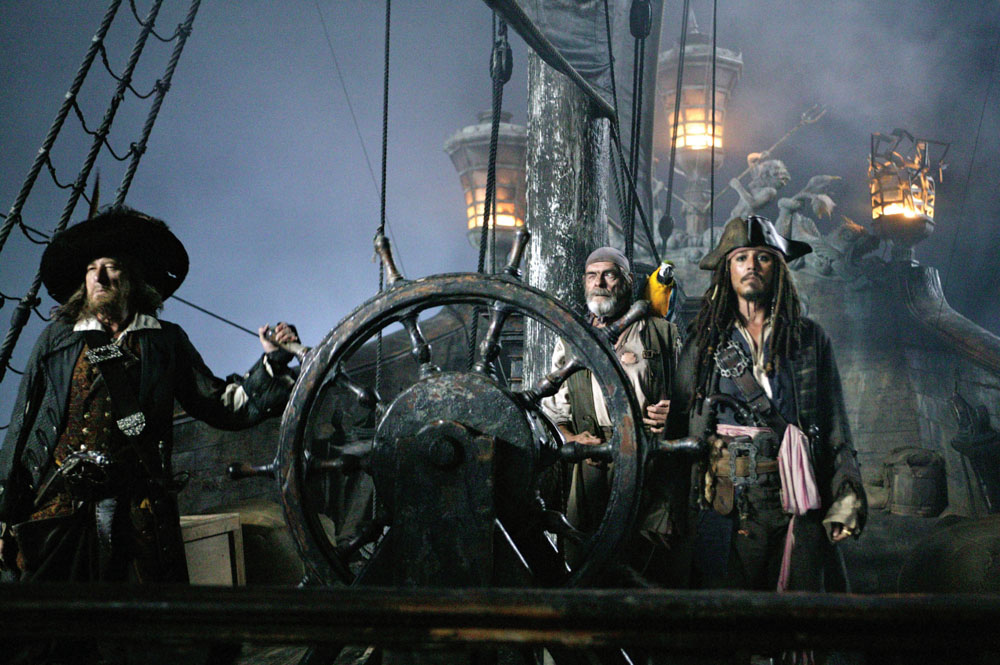
Pirates
of the Caribbean: Dead Men Tell No Tales (released internationally as Pirates of the Caribbean: Salazar's Revenge) is a 2017 American swashbuckler fantasy film directed by Joachim Rønning and Espen Sandberg. It is written by Jeff Nathanson, from a story by Nathanson and Terry Rossio. Produced by Jerry Bruckheimer and distributed by Walt Disney Studios Motion Pictures, the film is the standalone sequel to On Stranger Tides (2011) and the fifth installment in the Pirates of the Caribbean film series. The film stars Johnny Depp, Javier Bardem, Geoffrey Rush, Brenton Thwaites, Kaya Scodelario, and Kevin McNally. The story follows Captain Jack Sparrow (Depp) searches for the Trident of Poseidon to defeat Armando Salazar (Bardem), who is determined to kill every pirate at sea and take revenge on Sparrow for imprisoning him and his crew of ghosts in the Devil's Triangle. Jack is joined by Hector Barbossa (Rush), Will Turner's son Henry (Thwaites), young astronomer Carina Smyth (Scodelario) and Jack's first mate Joshamee Gibbs (McNally) to defeat Salazar's ghostly crew.
The filmmakers cited the series' first installment, The Curse of the Black Pearl (2003), as inspiration for the script and tone of the film, with critics describing the film as a "requel". Pre-production for the film started shortly before On Stranger Tides was released in early 2011, with Terry Rossio writing the initial script. In early 2013, Jeff Nathanson was hired to write a new script for the film, with Depp being involved in Nathanson's writing process. Initially planned for a 2015 release, the film was delayed to 2016 and then to 2017, due to script and budget issues. Principal photography started in Australia in February 2015, after the Australian government offered Disney $20 million in tax incentives, and ended in July 2015.
Dead Men Tell No Tales premiered in Shanghai on May 11, 2017, and was released in the United States on May 26. The film received generally negative reviews from critics and grossed $796 million worldwide against a production budget of $230–320 million.
PLOT
Thirteen years after the battle of Calypso's maelstrom, a twelve-year-old Henry Turner boards the Flying Dutchman and informs his father, Will, that the curse which binds Will to the Dutchman and only permits him to step on land once a decade can be broken by the Trident of Poseidon. Henry intends to recruit Captain Jack Sparrow to help find it, but Will believes this is impossible and orders Henry to leave. Will and the Dutchman then disappear into the sea, but Henry vows to find Jack and the Trident.
Nine years later, in 1751, Henry is a midshipman in the Royal Navy. His ship sails into the supernatural Devil's Triangle and stumbles upon the wreck of the Silent Mary, whose undead crew led by Spanish pirate-hunter, Captain Armando Salazar, slaughter the sailors but leave Henry as the sole survivor so that he can deliver a message to Jack, who led them to the Triangle decades ago, causing the downfall of Salazar and his crew and inadvertently cursing them.
On Saint Martin, a young astronomer named Carina Smyth is sentenced to death for witchcraft but escapes and crosses paths with Jack as he and his crew botch a bank robbery, suffering from a spell of bad luck. Jack later trades his compass for a drink, an act that destroys the Devil's Triangle and frees Salazar and his crew once more. Carina learns Henry is looking for the Trident's location and offers to help him using her unknown father's diary. Carina and Jack stall the execution process, but they escape with the help of Henry and Jack's crew, setting sail on the Dying Gull. Carina deciphers the clues in her diary, discovering that the stars will lead to an island where the Trident is hidden.
Meanwhile, Captain Hector Barbossa hears from his pirate crew that the revived Captain Salazar has killed several pirates at sea and is destroying Barbossa's fleet. Barbossa talks his way out of being killed by offering to help find Jack and learns that the Trident could lead him to a "treasure". Salazar agrees, wanting revenge on Jack. Salazar pursues the Dying Gull, forcing Jack, Henry, and Carina to flee to an island, discovering that Salazar's crew cannot go on land. Barbossa allies himself with Jack, returning his compass and restoring the miniaturized Black Pearl to its original size. They continue their journey to the island, with Barbossa taking command of the Pearl once more. During the voyage, Jack and Barbossa realize Carina is the latter's long-lost daughter.
The Pearl approaches the Trident's island and evades a Royal Navy warship until it is destroyed by the Silent Mary before the Pearl runs aground on the island. Jack, Barbossa, and Carina use the island's magic to part the ocean which opens a path to the Trident on the ocean floor. Salazar captures Henry and possesses him to walk on the ocean floor and seize the Trident. Once he does so, Henry is given his body back, and Jack distracts Salazar, allowing Henry to destroy the Trident, breaking all curses upon the sea and restoring Salazar's crew to life. However, the Trident's destruction causes the divided sea to close in on them. The Pearl lowers its anchor to lift the group to safety, but Salazar pursues them, still hell-bent on killing Jack. Carina realizes that Barbossa is her father when she spots a tattoo on his arm identical to the diary's cover, a trident star formation. Barbossa sacrifices himself to kill Salazar, allowing the others to escape.
Sometime later, Henry and Carina reach Port Royal, where Will appears, free from the Dutchman. His wife, Elizabeth Swann, appears moments later and the Turner family reunites. Henry and Carina kiss. Jack watches from the Pearl before sailing away into the horizon, captain once again, while also adopting Captain Barbossa's monkey Jack.
In a post-credits scene, Will and Elizabeth are asleep in their bed, when Davy Jones appears in their room. When he prepares to strike the couple, Will wakes up to find no one in the room. Assuming he had a nightmare, he goes back to sleep, oblivious to the wet barnacles on the floor.
CAST
- Johnny Depp as Captain Jack Sparrow: The former Captain of the Black Pearl who travels with Henry and Carina in search of the Trident of Poseidon. Rønning wanted to focus on relatable characters, as in the first film, "where Jack is not the [lead ... but] comes in and crashes the party every now and then," and to make use of Depp's "comedic genius". The film examines Jack's backstory, with the young Jack portrayed by Anthony De La Torre, whose face was replaced by a CGI replica of Depp as he looked in 21 Jump Street and What's Eating Gilbert Grape (1993). Rønning felt de-aging Depp was tricky against the canon of the franchise.
- Javier Bardem as Captain Armando Salazar: The undead Captain of the Silent Mary who seeks revenge on Jack Sparrow and attempts to steal the Trident of Poseidon to kill every pirate at the sea. Bardem set out to imbue the character with "a rage based on dented pride," owing to his spectacular fall, from a high-ranking commander of a Spanish fleet to being betrayed and trapped in hell by Jack. With Salazar's body language, he tried to convey a bull in an arena, "full of rage and need of vengeance, but also wounded." It took three hours a day to apply the make-up, which Bardem referred to as having "cold chicken breasts" glued to his face.
- Geoffrey Rush as Captain Hector Barbossa: Sparrow's rival, the former Captain of the Black Pearl, and the Captain of the Queen Anne's Revenge. On the character's role of having settled into a growing and prosperous pirate empire, Rush said, "Barbossa has become extremely wealthy. He's got more money than he can deal with and he's not a guy of high taste. He's running a very big empire, maybe 10 or 12 ships, so he's the kingpin."
- Brenton Thwaites as Henry Turner: The son of Will Turner and Elizabeth Swann who vows to break his father's curse by searching for the Trident. The directors were keen to draft a new protagonist relationship with Henry and Carina, stating that "in the middle of a big action scene, you need to be able to lean on the characters and find the heart of that story, and channel the characters' vulnerability." Rønning noted that identity is a major theme in the film, and to Henry and Carina's story arc: "they are on a similar quest and find common ground in looking for who they are." Lewis McGowan portrays a young Henry.
- Kaya Scodelario as Carina Smyth: A headstrong, altruistic astronomer who was wrongly accused of being a witch. Scodelario explained the character's motivation and role, saying, "she is an academic, she's fighting for the right to study at university because women couldn't at that time." For the directors, it was important to "modernise it with Henry and Carina, Kaya, especially brought that with her. She's a modern woman." Scodelario worked with scriptwriter Jeff Nathanson to ensure the character was unique to the series and not a copy of Elizabeth Swann. She said that female characters often "fall into two camps; they are either pretty and perfectly put together or completely insane. Carina has definitely got a little bit of both."
- Kevin McNally as Joshamee Gibbs: Captain Jack's loyal friend and first mate.
- Orlando Bloom reprises his role as Will Turner, a blacksmith-turned-pirate who was transformed into the Captain of the Flying Dutchman at the end of At World's End (2007). In preparation for his role, Bloom stated that he would like to portray a character outside of his usual role types as a good-looking hero, alluding to the make-up requirements for Davy Jones, as Bloom having his possible return in the franchise.
- Keira Knightley briefly appears at the end in a non-speaking role as Elizabeth Swann, Will's wife and Henry's mother, following the "demand" that the character be added after test screenings.
Supporting characters appearing in the film include: David Wenham appears as Lieutenant John Scarfield, a Royal Navy officer, who commands HMS Essex; Golshifteh Farahani appears as Shansa, a sea witch; and Stephen Graham, Martin Klebba, Giles New, and Angus Barnett reprise their roles as Scrum, Marty, and Murtogg and Mullroy, respectively, from previous films, as the members of the pirate crew.
Adam Brown, Danny Kirrane, and Delroy Atkinson appear as members of Jack's crew, and in the prison scene, Paul McCartney briefly appears as Jack's paternal uncle, Uncle Jack. A CGI silhouette of Davy Jones is seen in the post-credits scene, but actor Bill Nighy stated that he had not been informed about the character's appearance.
PRODUCTION &DEVELOPMENT
Shortly before the release of On Stranger Tides, the cast and crew of the fourth film were told to set aside time in the near future, because Walt Disney Pictures intended to shoot a fifth and sixth film back-to-back. However, it was later stated that only a fifth film was in the works, with Terry Rossio writing a script for a fifth film without his partner Ted Elliott. Rob Marshall was rumoured to return to direct, but declined after choosing to direct Into the Woods (2014). After Marshall passed on the film, many directors were rumored to take over. Gore Verbinski, who was responsible for the original three films, felt that "there's no reason other than financial" in making the film. The eventual shortlist included Fredrik Bond, Rupert Sanders, and the eventual choice, Norwegian film duo Joachim Rønning and Espen Sandberg. The studio chose them based on their Academy Award-nominated high-sea film Kon-Tiki, and their ability to work with a limited budget.
Rossio's script was ultimately rejected, and the writer stated that a major reason was its use of a female villain, which made actor Johnny Depp "worried that would be redundant to Dark Shadows (2012), which also featured a female villain." In January 2013, Disney hired Jeff Nathanson to work on a script. Rønning and Sandberg said they were particularly moved by Nathanson's "funny and touching" script, which convinced them to sign to direct in May, Rønning believing that the script was "all there" but needed scenes to "carry the tradition of Gore Verbinski, bring the emotional core and big action set pieces." In August, Rønning and Sandberg revealed that the title would be Dead Men Tell No Tales. However, the following month producer Jerry Bruckheimer said, "We have an outline everyone loves but the script is not done," explaining that the release would be postponed beyond summer 2015. The studio questioned Depp's bankability following the financial losses of The Lone Ranger (2013), and the screenplay's first drafts were not approved by Walt Disney Studios chairman Alan Horn, who was concerned about the finished product. Bruckheimer revealed that script and budget issues were behind the delay, and that Nathanson was at work on a second draft, based on a well-received outline, saying they needed a script and budget everyone would approve. Depp was also invited to collaborate on the script, with the actor believing it would be the last of the franchise and wanting to end it right. After the script was accepted, the film was officially green-lit by Disney in July 2014, with a planned release on July 7, 2017.
The directors were inspired by the first film, The Curse of the Black Pearl, stating that the original is thrilling but above all a comedy with heart, and wanted to reinvent the "structure and the dynamics between the characters." In addition to recapturing the best of previous franchise installments, the directors had the works of Charlie Chaplin and Buster Keaton in mind when crafting the tone of the film. The pair wanted the film to be the "most emotional" of the series, and to explore the roots of Jack Sparrow. They decided to use Jack's compass as the "key to unlock Salazar from his hellish prison in the Triangle," and toned down some of the fantastic elements "to ground it, even in Pirates Of The Caribbean [sic]." Geoffrey Rush argued that the pair brought "Euro sensibility to traditional Hollywood franchise thinking," while Orlando Bloom believed that they had "recaptured the simplicity and charm" of the original film. Kaya Scodelario said that the producers wanted to take the franchise back to its origins, with a story that gave characters a conclusion while opening new
possibilities. Along with the directors and writers, many of the crew members were new to the franchise, replacing those who had served on the previous four films, with the exception of Bruckheimer, costume designer Penny Rose, and executive producer Chad Oman.
CASTING
Speaking at the On Stranger Tides press launch in Cannes, Depp said he would play the role so long as it is popular with the
public. In August 2012, news surfaced that Depp had signed for the fifth film, earning A$90 million to reprise his
role. One month later, Penélope Cruz stated that in spite of her enjoying playing Angelica in On Stranger Tides, she had not been contacted regarding a fifth
film. Geoffrey Rush had commented on returning as Hector Barbossa in the fifth installment, saying "If they keep shapeshifting this character, absolutely," and implied that he might return as the villain.
Orlando Bloom commented in December 2014, saying that while he was not sure whether he would return as Will Turner, there were talks. He also indicated that Disney could make a soft reboot with the franchise and focus on Will and his son. Both Will Turner's return and Bloom's participation was kept secret until the Disney D23 in 2015, after filming had wrapped. Despite having previously stated that she wouldn't return in 2014, there were reports suggesting that Keira Knightley would reprise her role as Elizabeth Swann due to Will returning. Once the film was shown to test audiences, the filmmakers felt they were "demanded" to reunite both Will and Elizabeth's character. To ensure that Knightley could reprise this role, the production moved for a one-day shoot in London, where she was working.
On December 2, 2013, it was reported that Christoph Waltz was in talks to appear as the film's main antagonist, but he later declined. The villain was eventually portrayed by Cruz's husband, Javier Bardem. In 2014, Bardem signed on to portray Armando Salazar, who in early scripts was referred to as Captain John Brand. Bardem had liked the working environment of the fourth movie, which he witnessed accompanying his wife, and stated he was also a fan of the franchise and of Depp's performance as Jack Sparrow. Australian actor Brenton Thwaites entered talks for the role of Henry in late November 2014, after Disney chose him over Taron Egerton, George MacKay, Mitchell Hope, Ansel Elgort, and Sam Keeley.
Kaya Scodelario was chosen as the female lead out of a shortlist that included Gabriella Wilde, Alexandra Dowling, Jenna Thiam, and Lucy Boynton. Her character, Carina, is an astronomer accused of being a witch. Scodelario confirmed that she was playing "a totally different character" from Elizabeth Swann, and also that she will be Henry's love interest, given in earlier drafts she was envisioned as a love interest of Sparrow. Kevin McNally confirmed his return as Joshamee Gibbs in late January. Adam Brown, Delroy Atkinson, and Danny Kirrane were revealed as cast members shortly before filming. As filming begun, two actors from the previous films were confirmed to return, Martin Klebba as Marty and Stephen Graham as Scrum. Keith Richards expressed interest in reprising his role as Captain Teague, but was unavailable, leading Depp to invite Paul McCartney into appearing as Jack Sparrow's uncle (also named Jack).
Other actors had expressed interest in reprising their roles from the previous films, such as Tia Dalma portrayer Naomie Harris, and Greg Ellis, even if his character Theodore Groves appeared to die in the previous film. Both Lee Arenberg and Mackenzie Crook commented on the possibility of returning as Pintel and Ragetti. In an interview on November 7, 2014, Crook confirmed that he had received a call of availability from Disney for the film, though he later declined in order to focus on his television series Detectorists. He said he had felt "pangs of nostalgia" when the cast and crew filmed without him. Arenberg, who also had a television commitment, to Once Upon a Time, added that he felt like the producers "weren't really trying to court us like they really wanted us."
FILMING
Directors Joachim Rønning and Espen Sandberg originally stated that shooting would take place in Puerto Rico and New Orleans, and Bruckheimer had previously mentioned that there might be a sequence in Louisiana. However, a spokesman for Australian Arts Minister George Brandis confirmed that the fifth installment was set to shoot exclusively in Australia after the government agreed to repurpose $20 million of tax incentives, originally intended for the remake of 20,000 Leagues Under the Sea; thus edging out Mexico and South Africa as filming locations. Filming took place exclusively in Queensland, Australia, as the largest production to ever shoot in the country. Village Roadshow Studios and the Whitsunday Islands were officially confirmed as filming locations. On January 1, 2015, The Rainbow Gypsy, a 35-year-old replica of an 1897 Scottish trawler, underwent an extensive refit at the Gold Coast, including a new bowsprit, and reconfigured decks and cabins, for filming as the Dying Gull. Its captain and owner, Kit Woodward, was a rigger in the film.
Filming commenced on February 17, 2015. Ship scenes were filmed in front of a giant outdoor greenscreen in
Helensvale, while a film set in the form of a village was built in
Maudsland. Because the greenscreens' height blocked the sunlight, containers with inflatable bluescreens mounted on top were added to the set to allow some light to enter. While an initial draft of the script featured six ships, the end product had eleven vessels; to cut costs, most of these were partial constructs later enhanced by computer graphics, with some built atop a hydraulic rig to mimic the movement of seafaring while on land. The camera crew, led by the director of photography Paul Cameron, also made extensive use of drones, to capture immersive views at sea without resorting to aerial footage or cranes.
Filming moved to Doug Jennings Park on the Spit from March 30 to June 15 for water-bound scenes. However, due to extreme sea sickness among the cast and crew from the "big swells," filming moved to Raby Bay for calmer waters. Scenes were shot at Byron Bay on June 1. Locals made up more than 75 percent of the 850-plus crew then working on the film. After much speculation about whether Orlando Bloom would return, Bloom arrived at the Gold Coast in late May to reprise his role as Will Turner. Scenes featuring a skeleton of a sperm whale that had been constructed were shot at Hastings Point from June 21 to 23.
A number of issues and controversies set back the film during its production. The
bio-security laws in Australia posed problems regarding the capuchin monkeys that portray Hector Barbossa's pet monkey Jack, because the animals are regarded as a category 1 pest and call for strict requirements and a 30-day quarantine. Further controversy erupted from animal rights activist groups, who urged Federal Environment Minister Greg Hunt to reject the entry application, arguing that the long air-flight would affect their health, and that their performance was unnatural and would create demand for illegal wildlife trade. The three activist groups were Humane Society International Australia, WildFutures, and the Captive Animals Protection Society (Freedom for Animals/FFA). One of the monkeys caused further disruption when it wandered off set at Movie World, and bit the ear of a make-up artist on another production set for Mako Mermaids.
Crew and cast members were forced to cover the camera lenses on all mobile phones with duct tape to prevent the film from being pirated before its release. To prevent fans from interfering with the production, secret filming locations used the production name of "Herschel" to hide the fact it was the fifth Pirates of the Caribbean film. Following the attempt of an armed man trying to bypass security, the already tight security was increased.
On March 10, 2015, Depp was injured off set and had to be flown to the United States for
surgery. Due to his absence, filming stalled completely and 200 crew members were forced to stand down for two weeks, after finishing all they could do without Depp. Depp returned to set on April 21. In June, Kaya Scodelario was injured on set along with a stuntman. In early July, dismantling of the sets at the Spit had begun. Most of the cast and crew had finished on July 8, and a wrap party was held on July 11. Filming then moved to the Whitsundays for the final shots. On July 21, 2015, Rønning announced that filming had wrapped after a 95-day shoot. After nearly a year in post-production, reshoots and additional photography were conducted in Vancouver, Canada from March 24 to April 13, 2016, under the production title "Herschel Additional Photography".
POST PRODUCTION
Editing was a collaboration between Roger Barton and Leigh Folsom Boyd, with the latter detailing that "Roger started from the beginning of the film and I started from the end, and we kind of met in the middle." Boyd added that it was the longest post-production process she was ever involved with, as Disney wanted to give "the support and leeway we needed to tell the story and allow for the complex visual effects to bake." The editors worked closely with the previsualization team to, according to effects supervisor Gary Brozenich, "give meat to the bones of the plates that needed effects explanation as well as any new CG beats that would be added later." Along with the post-production team in Los Angeles, Brozenich had to split his time going to the UK and Montreal, to check on the eight companies handling the film's 2,000 visual effects shots, with 150 of them consisting only of computer graphics. The primary vendor was Brozenich's own employer Moving Picture Company (MPC). Among MPC's work were Salazar's undead pirates, whose on-set footage was mostly replaced by CGI to achieve missing body parts and floating hair and clothing. Brozenich stated that what was kept of the original actors was "their run, gait and faces." To provide reference for the floating parts, which were meant to resemble a perpetual drowning state, a stuntman in full costume and wig was filmed underwater in a swimming pool performing various actions.
Atomic Fiction handled the scenes at St. Martin, turning the few blocks of buildings built on set into more than 600 CG buildings, surrounded by a jungle environment. The work combined references from both the Caribbean and Thailand, and enhanced through CGI both the guillotine on which Jack Sparrow is nearly executed and the bank from the heist scene; the bank was meant to look as if its foundations were dug through the ground instead of sliding on the
surface. Along with sea footage filmed in both the Australian sets and Key West, Florida, there was extensive usage of water simulations, with the artists using the Beaufort scale to ensure the waves and wind realistically matched.
CRITICS & BOX OFFICE
Pirates of the Caribbean: Dead Men Tell No Tales grossed $172.6 million in the United States and Canada, and $623.4 million in other territories, for a worldwide total of $795.9
million, against an estimated production budget of $230 million. It had a worldwide opening of $271.4 million from 55 markets, with $24 million coming from 1,088 IMAX screens. The film's six-day opening gross pushed the franchise gross past the $4 billion mark. Despite being the lowest-grossing film of the series in North America by nearly $70 million and despite scoring the second-lowest nominal gross of the franchise outside North America (only ahead of Curse of the Black Pearl), Dead Men Tell No Tales became the highest-grossing entry of the Pirates franchise outside North America when accounting for foreign-exchange rates, surpassing On Stranger Tides, which grossed $593.4 million at July 2017 rates. The largest-earning foreign markets were China ($172.3 million), Japan ($59.5 million), and Russia and the CIS ($40.7 million), where it was the second-highest-grossing film behind Avatar (2009). Deadline Hollywood noted the film would turn a net profit of around $280 million after factoring together all expenses and revenues based on a projected $850 million final gross (though it would ultimately fall short of that figure, likely resulting in a smaller profit).
Dead Men Tell No Tales debuted over the four-day Memorial Day opening weekend, being released in 4,276 theaters, of which over 3,100 were 3D, taking advantage of formats such as IMAX, D-Box, and 4DX. The film earned $23.4 million on its first day, including $5.5 million from previews. It was the lowest opening day of the franchise. Dead Men Tell No Tales grossed $63 million over three days, and $78.5 million over four (Friday–Monday), finishing first at the box office, ahead of Guardians of the Galaxy Vol. 2 (2017) and fellow newcomer Baywatch (2017). It was the second-smallest opening weekend of the franchise, only earning more than the first film, with each of the other installments earning at least $90 million. Despite the film registering the highest test score in the series, the opening came in well below expectations of $80–115 million. Analysts attributed the underperformance to negative reviews, franchise fatigue, and Johnny Depp's diminishing returns and depreciating public image, amid his personal problems. Still, it performed better than Disney's previous Memorial Day releases (Prince of Persia: The Sands of Time (2010), Tomorrowland (2015), and Alice Through the Looking Glass (2016)), and studio executives said they were pleased with the movie's opening, which helped Disney push past $1 billion in the US.
The film fell by a total of 65% in its second weekend, the worst of the series, grossing $22.1 million, and finishing in third place, after newcomers Wonder Woman (2017) ($103.3 million) and Captain Underpants: The First Epic Movie (2017) ($23.9 million). It remained in the top ten for four more weeks.
Marketed as Salazar's Revenge in most countries, the film was released day-and-date with its debut in 54 markets (91% of its total marketplace, except Japan, where it debuted on July 1). Preliminary reports had the film opening to $150–175 million, but possibly overperforming depending on major markets, most notably China. While its Chinese run benefited from the May 28–30 Dragon Boat
Festival - a lucrative moviegoing period - and from International Children's Day (June 1), the Manchester Arena bombing had a deteriorating effect on certain European markets over the film's opening weekend. From Wednesday to Friday, it registered an opening of $208.8 million. Around $14 million of that came from IMAX screenings, the second-biggest international IMAX opening in May, after Captain America: Civil War (2016). Similar to its US plunge, it earned $73.8 million in its second weekend, falling to second place, behind Wonder Woman.
It recorded the biggest opening day of the year in several markets, including Germany ($3.6 million), Austria, France ($2.3 million), Finland, Sweden, Belgium, Thailand ($400,000), Indonesia, Malaysia, and the Netherlands ($900,000). Russia posted the biggest opening of all time with $18.4 million ($18.6 million including previews). In China, where the film had its global premiere, it earned $21.3 million on its opening day, the fourth-biggest Disney opening in the country. It had an 87% marketshare and had already surpassed the entire earnings of Pirates of the Caribbean: At World's End. Earning a total of $67.9 million, it registered the third-highest three-day for any Disney title, and a much-higher opening than the US. The film did extremely well in IMAX, earning $9 million from 401 screens from Friday to early Monday bookings. The robust opening has been attributed to the Dragon Boat Festival, Depp's star power, the ubiquity of the franchise, the impact of Shanghai Disneyland Park, and good word of mouth, with a score of 7.5/10 on reviews aggregator Douban and 8.7/10 on top mobile-ticketing platform Weying. The film's final release market was Japan (July 1), where it opened at number one, achieving the highest-grossing opening for a Western film of the year, earning $9.25 million over the July 1–2 weekend. It retained the box office lead for one more week, and was the highest-grossing foreign film in the following weekend.
On the review aggregator website Rotten Tomatoes, 30% of 294 critics' reviews are positive, with an average rating of 4.7/10. The website's consensus reads: "Pirates of the Caribbean: Dead Men Tell No Tales proves that neither a change in directors nor an undead Javier Bardem is enough to drain this sinking franchise's murky
bilge." Metacritic, which uses a weighted average, assigned the film a score of 39 out of 100, based on 45 critics, indicating "generally unfavorable" reviews. Audiences polled by CinemaScore gave the film an average grade of "A−" on an A+ to F scale, and PostTrak reported 81% of those gave the film a positive score.
Mike Ryan of Uproxx criticized what he termed as a convoluted plot and overabundance of characters, resulting in a film that was "practically incoherent." Writing for Rolling Stone, Peter Travers called the film "bloated, boring, repetitive, and draining" and gave it one star out of four. Ignatiy Vishnevetsky of The A.V. Club wrote that the film echoes the first three of the franchise, "in which Johnny Depp's louche and campy Jack Sparrow played second banana to an insipid love story... the two romantic leads ... succeed only in making the shortest movie in the series seem just as long as the rest." A. O. Scott of The New York Times said of the film, "Its pleasures are so meager, its delight in its own inventions so forced and false, that it becomes almost the perfect opposite of entertainment." Michael O'Sullivan of The Washington Post remarked that the film was "loud, overstimulating and hard to take in all in one sitting." Mick LaSalle of San Francisco Chronicle found the film to be "a jumble of half-baked impulses" that had been forced into a played-out franchise.
Richard Roeper of Chicago Sun-Times gave the film three stars out of four, saying: "Dead Men works well enough as a stand-alone, swashbuckling comedic spectacle, thanks to the terrific performances, some ingenious practical effects, impressive CGI and a steady diet of PG-13 dialogue peppered with not particularly sophisticated but (I have to admit) fairly funny sexual innuendo." Pete Hammond of Deadline Hollywood praised the film, calling it "the most entertaining installment," and giving credit to Rønning and Sandberg for creating a "rollicking good time". He praised the visual effects, particularly Salazar and his crew, arguing that the film should be in line to receive an Academy Award for Visual Effects. He also gave high praise to Bardem for being able to create such a "fully dimensional villain" under the layers of make-up and CGI, and Depp for keeping the film and franchise going. Leah Greenblatt of Entertainment Weekly gave the film a 'B', praising the fun nature of the film and its visuals and calling it "gorgeously detailed swashbuckling nonsense," but wished that the script had taken more risks instead of following the formula used in previous films. Ashley Esqueda of CNET gave the film a positive review, arguing that it brought the franchise back to what made its first two installments so fun, and praised Depp's performance as being "delightful as ever." Brian Truitt of USA Today gave the film three stars out of four, saying "What was once a past-its-prime franchise seems to have found new life."
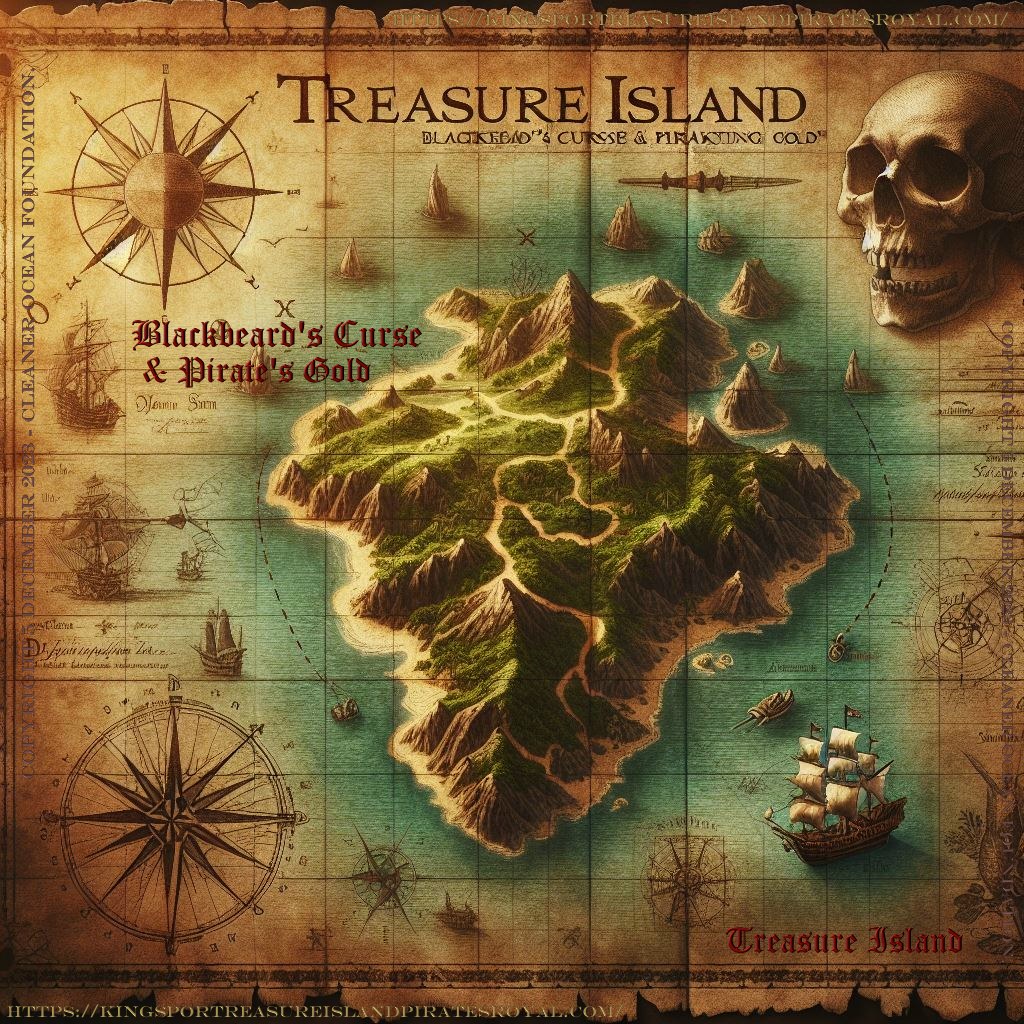
PIRATES
OF TORTUGA
Disney
made an excellent series of fantasy swashbuckler films based on the legendary haunt, Tortuga,
and piracy, a formula that made Errol Flynn famous as a privateer for Good
Queen Bess, romanticizing the plundering and treasure hunting, with
British Naval officers as some of the antagonists.
The series is intermingled with ghost ships and pirates, that are
cursed, relying heavily on CGI for effects - that are excellent in the
main, if a little overdone on the skeletal ghost front. A little goes a
long way!
The
key players of the Pirates of the Caribbean film
series are Johhny Depp as Captain Jack Sparrow,
Elizabeth Swann (Keira
Knightly)
and Geoffrey Rush as
Captain Hector Barbossa, with Orlando
Bloom as Will Turner.
Pirates
of the Caribbean was produced by Jerry
Bruckheimer and based on Walt Disney's theme park attraction of the
same name. The film series serves as a major component of the eponymous
media franchise.
Directors of the series include Gore
Verbinski (films 1–3), Rob Marshall (4),
Joachim Rønning (5–6),
and Espen Sandberg (5). The series is primarily written by
Ted Elliott
and Terry Rossio (1–4); other writers include Stuart Beattie (1), Jay Wolpert (1), Jeff Nathanson (5), Craig Mazin (6).
The stories follow the adventures of
Captain Jack Sparrow (Johnny Depp), Will Turner
(Orlando Bloom) and Elizabeth Swann (Keira Knightley). Characters such as Hector Barbossa (Geoffrey Rush) and Joshamee Gibbs
(Kevin McNally) follow Jack, Will and Elizabeth in the course of the films.
The fourth film features Blackbeard
(Ian McShane) and Angelica (Penélope
Cruz), while the fifth film features Armando Salazar (Javier
Bardem), Henry Turner (Brenton
Thwaites) and Carina Smyth (Kaya
Scodelario).
The films take place in a fictionalized historical setting; a world ruled by the
British
Empire, the East India Trading Company (based on the real East India Trading Company) and the Spanish Empire, with pirates representing freedom from the ruling powers.
The film series started in 2003 with Pirates of the Caribbean: The Curse of the Black Pearl, which received positive reviews from critics and grossed US$654 million worldwide.
After the first film's success,
Walt Disney Pictures revealed that a film series was in the works. The franchise's second film, subtitled Dead Man's Chest, was released three years later in 2006; the sequel proved successful, breaking financial records worldwide the day of its premiere.
Dead Man's Chest ended up being the number one film of the year upon earning almost $1.1 billion at the worldwide box office.
The third film in the series, subtitled At World's End, followed in 2007 earning $960 million, and Disney released a fourth film, subtitled On Stranger Tides, in 2011 in conventional 2D, Digital 3-D and IMAX 3D. On Stranger Tides succeeded in also grossing more than $1 billion, becoming the second film in the franchise and only the eighth film in history to achieve this.
The franchise has grossed over $4.5 billion worldwide; it is the 14th-highest-grossing film series of all time, and is the first film franchise to produce two or more movies that grossed over
$1
billion.
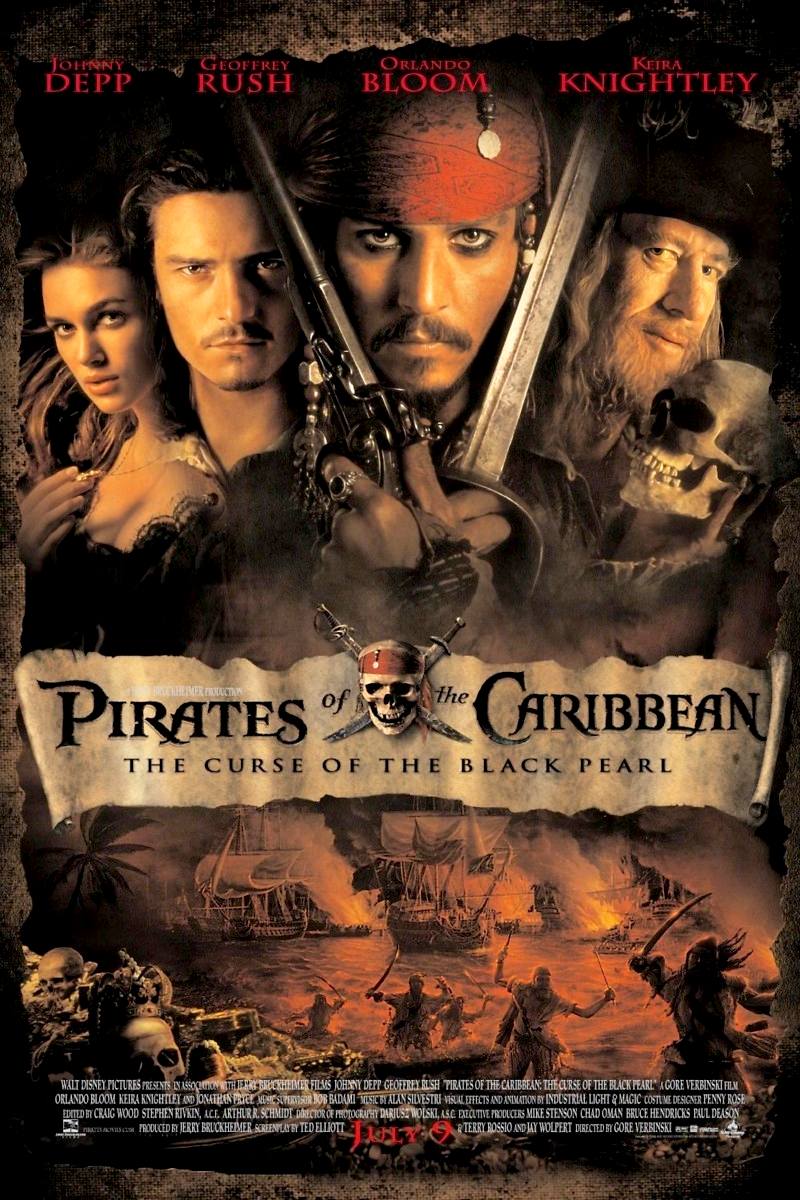
1. Pirates of the Caribbean: The Curse of the Black Pearl (2003)
Blacksmith Will Turner teams up with eccentric pirate Captain Jack Sparrow to save Turner's love, Elizabeth Swann, from cursed pirates led by Jack's mutinous former first mate, Hector Barbossa. Jack wants revenge against Barbossa, who left him stranded on an island before stealing his ship, the Black Pearl, along with 882 pieces of cursed Aztec Gold.
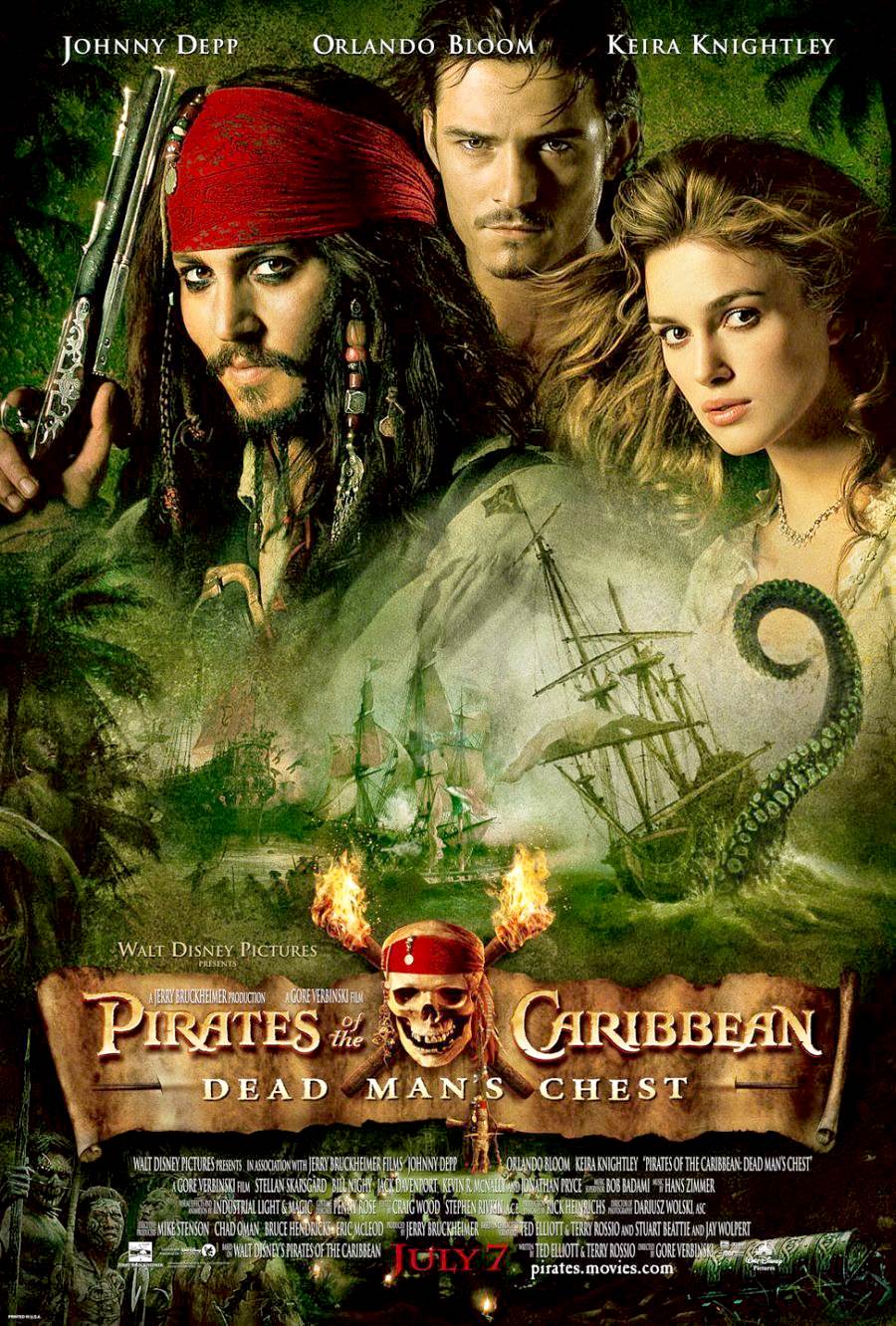
2. Pirates of the Caribbean: Dead Man's Chest (2006)
Lord Cutler Beckett of the East India Trading Company arrests Will and Elizabeth for aiding Captain Jack Sparrow in the previous film. Beckett offers clemency if Will agrees to search for Jack's
compass in a bid to find the Dead Man's Chest
- and inside, the heart of villainous Davy Jones - which would give Beckett control of the seas. However, Jack wants the Chest to escape from an unpaid debt with Jones, who made Jack captain of
the Black Pearl for 13 years in exchange for 100 years of service aboard Jones' ship,
the Flying Dutchman.
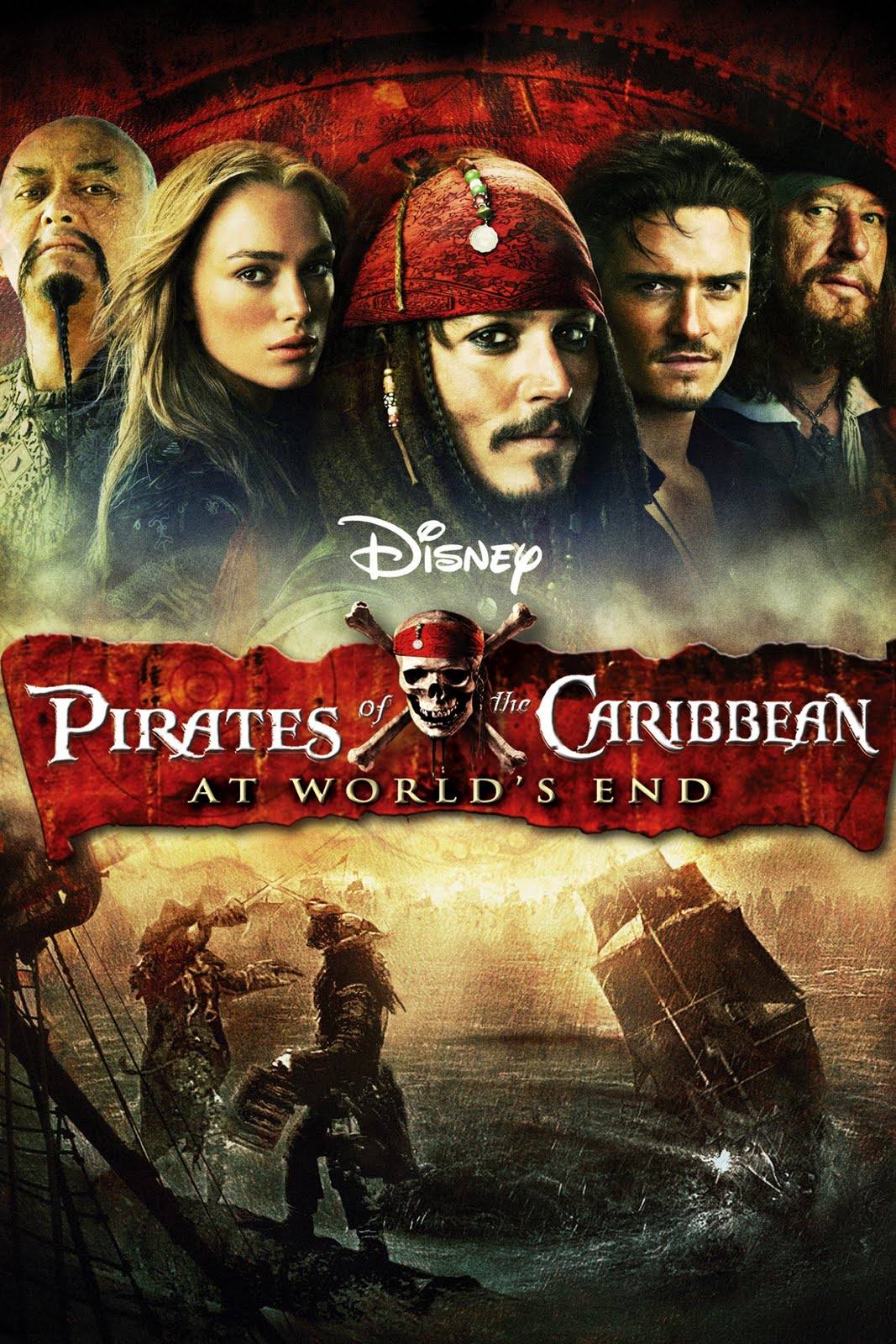
3. Pirates of the Caribbean: At World's End (2007)
Lord Beckett gains power over Davy Jones and, with the help of the Flying
Dutchman, he is now executing his plans to extinguish piracy forever. To stand against the East India Trading Co., Will, Elizabeth, Barbossa, and the crew of the Black Pearl set out to rescue Captain Jack Sparrow from Davy Jones' Locker. As one of the Nine Pirate Lords, Jack is needed in order to release an ancient goddess with the power to defeat Beckett's forces.
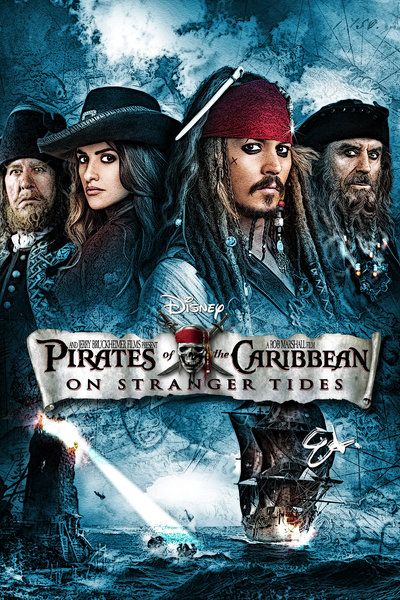
4. Pirates of the Caribbean: On Stranger Tides (2011)
Captain Jack Sparrow is on a quest to find the fabled Fountain of Youth and crosses paths with a former lover, Angelica. She forces Jack aboard the
Queen Anne's
Revenge, a ship captained by the infamous pirate Blackbeard, Angelica's father. Both are also in search of the Fountain: Angelica to save her father's soul, Blackbeard to escape a prophecy of his demise at the hands of a one-legged man. Joining the hunt is former pirate captain Barbossa, now a privateer in King George II's Navy, who is in a race against the Spanish for the Fountain of Youth.
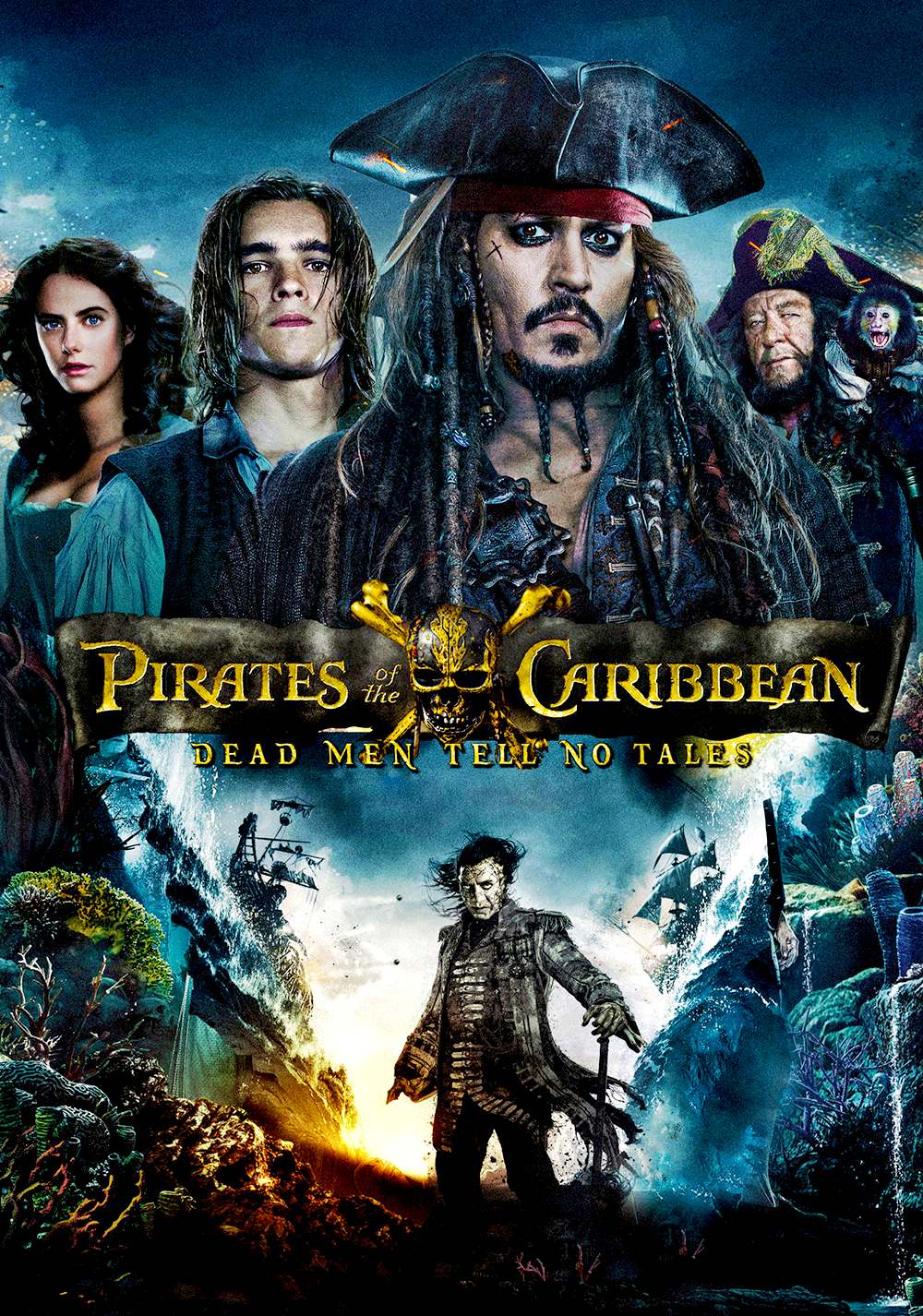
5. Pirates of the Caribbean:
Dead Men Tell No Tales (2017)
A group of ghostly Spanish Royal Navy soldiers led by Jack Sparrow's old nemesis, Captain Armando Salazar, escape from the Devil's Triangle, with the goal of killing every pirate at sea, including Sparrow. To survive, Sparrow seeks out the legendary Trident of Poseidon, a powerful artifact whose owner can control the seas, tides, aquatic animals and break curses.
6. Potential Sixth film
Shortly before the release of On Stranger Tides, it was reported that Disney was planning to shoot the fifth and the sixth films back-to-back, although ultimately only the fifth installment was developed. By March 2017, director Joachim Rønning stated that Dead Men was only the beginning of the final adventure, confirming that it would not be the last film of the series. In September 2017, producer Jerry Bruckheimer indicated that another Pirates of the Caribbean is still in development. In October of the same year, Kaya Scodelario stated that she is contractually signed to return for a sixth film. Shortly after, it was confirmed that Rønning will direct the film. In May 2020, there were reports that the studio were considering Karen Gillan, Daisy Ridley and Emma Watson for the female lead, while Bruckheimer commented that the first draft of the screenplay for the sixth film would soon be finished, adding that he was "unsure" of Depp's role in the movie.
7. Potential Spin-off film
In June 2020, it was announced that Disney was developing a female-led spin-off with Christina Hodson set to pen the screenplay and Margot Robbie attached to star. The film will be a separate from the sixth film currently being developed. Jerry Bruckheimer will also be attached to the project as producer.
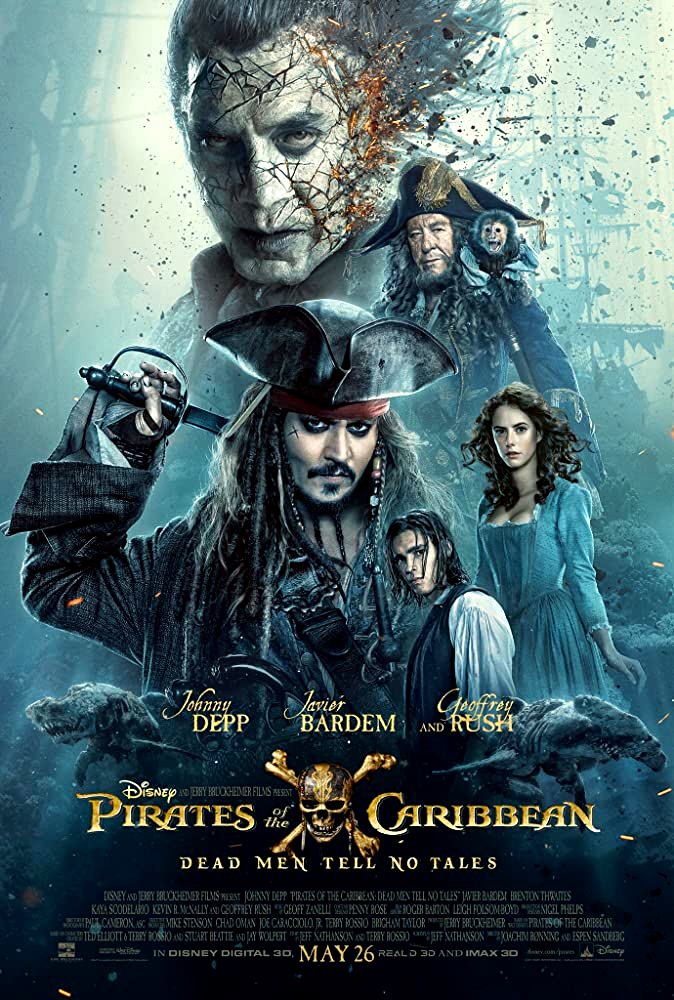
BOX OFFICE
1. The Curse of the Black Pearl July 9, 2003 $654,264,015 - Budget: $140 million
2. Dead Man's Chest July 7, 2006 $1,066,179,725 - Budget: $225 million
3.
At World's End May 25, 2007 $963,420,425 - Budget: $300 million
4.
On Stranger Tides May 20, 2011 $1,045,713,802 - Budget: $378.5 million
5.
Dead Men Tell No Tales May 26, 2017 $794,780,215 - Budget: $230 million
Total
Revenue: $4,524,358,182 - Budget $1.274 billion
Not
bad!
A
BIT OF PIRATE HISTORY
Pirates have existed since ancient times – they threatened the trading routes of ancient Greece, and seized cargoes of grain and olive oil from Roman ships. The most far-reaching pirates in early medieval Europe were the Vikings.
A life of Piracy on the high seas tempted poor seamen because it offered them the chance to take more control of their
lives and adventure. Ordinary seamen toiled for modest wages and were subject to strict discipline. In contrast, piracy offered sailors a chance to get rich quick as
equals or at least shareholders of captured booty.
ENGLISH SEA DOGS, PRIVATEERS
English Sea Dogs were pirates that sailed during the Privateering Era under the leadership of
Queen Elizabeth I between 1560 and 1605. During this time they had explicit permission from the Queen known as a Letter of Marque which allowed them to engage in acts of piracy against the Spanish and other colonial powers the English were at war with at the time.
One of the first well known English Sea Dogs would be John Hawkins who began in the mid 16th century. Hawkins would also be engaged in the slave trade as part of the Trans-Atlantic Triangular Trade. Another famous Sea Dog was
Francis Drake who raided Spanish settlements all across the world. One of Drakes most famous exploits was to sail around to the Pacific Coast and raid Spanish settlements before returning to England, completing his second
circumnavigation of the globe.
In 1588 the famous English Sea Dogs named Francis Drake, John
Hawkins, Walter Raleigh and Martin Frobisher were all part of the English naval forces that helped defeat the Spanish Armada and challenge Spanish naval
dominance. In 1604 when peace was made with Spain many of the Sea Dogs went to work in the Barbary States.
Overall the English Sea Dogs were responsible for striking great blows against the Spanish Main. Eventually they would be replaced by the English Buccaneers who operated throughout the Buccaneering Era and helped manage to establish actual colonies for the British Empire throughout the West Indies.
CORSAIRS
Corsairs were pirates who operated in the Mediterranean Sea between the 15th and 18th centuries. Muslim corsairs, such as the Barbarossa (red beard) brothers, had bases along North Africa’s Barbary Coast, while Christian corsairs were based on the island of Malta. Both used to swoop down on their targets in oar-powered boats called galleys, to carry off sailors and passengers. Unless these unfortunates were rich enough to pay a ransom, they were sold as slaves.
BUCCANEERS
Thousands of pirates were active between 1650 and 1720, and these years are sometimes known as the 'Golden Age’ of piracy. Famous pirates from this period include
Henry
Morgan, William 'Captain' Kidd, 'Calico' Jack Rackham, Bartholomew Roberts and the fearsome Blackbeard (Edward Teach).
By the beginning of the 18th century, piracy was becoming hard work. The Spanish galleons no longer plied the oceans with chests full of dubloons, and responsible governments with large navies were getting tired of pirates preying on their vessels.
Still, there was a living to be made by those who were prepared to take
risks. The famous pirate Blackbeard (Edward Teach) plundered successfully for nearly three years until, in a hand-to-hand fight with Lieutenant Maynard of the H.M.S. Pearl, he
was taught the difference between swinging a cutlass brutally and skill and
training with a blade. Twenty-five wounds later, Blackbeard expired on the deck.
In 1717, George I offered a general amnesty to all pirates who surrendered themselves before 5th September of the following year. Many members of the profession
decided to quit while ahead and settled down to become respectable citizens. There were a few
pirates who could not change their lives of piratical adventure. They were hunted down ruthlessly
until by 1725 it was just about over.
FRENCH
BUCCANEERS
French buccaneers were famous pirates of the Buccaneering Era that were from the French Empire. These buccaneers were responsible for establishing the first French colony in the New World in Spanish controlled La Florida that was known as Saint Caroline. However, this settlement of French huguenots was wiped out by the Spanish under the command of Pedro Menendez de Aviles who assaulted them from nearby Saint Augustine.
After this defeat the French buccaneers moved to the rocky outcrop island of Tortuga off the coast of Hispaniola and established
the famous pirate haven. They would clash with the Spanish for many decades and eventually be successful in not only claiming Tortuga but
a third of the island of Hispaniola as well that the French named Saint-Dominigue.
French buccaneers were just as famous as their English or Dutch counterparts.
Buccaneers lived on the Caribbean island of Hispaniola and its tiny turtle-shaped neighbour, Tortuga, in the 17th century. At first they lived as hunters, but later the governors of Caribbean islands paid the buccaneers to attack Spanish treasure ships. Although raids began in this way, with official backing, the buccaneers gradually became out of control, attacking any ship they thought carried valuable cargo, whether it belonged to an enemy country or not. The buccaneers had become true pirates.
Privateers, meanwhile, were privately owned (rather than navy) ships armed with guns, operating in times of war.
17th century pirates were also known as buccaneers and operating mostly during the Buccaneering Era. Called boucaniers, the English term 'buccaneers', these groups of French and English pirates would raid Spanish settlements and ships alike in a state sponsored piracy campaign.
The buccaneers of the 17th century were generally more ruthless, and merciless than the 18th century pirates.
Operating out of their bases at Port Royal and Tortuga, the 'Brethren of the Coast' were not pirates in the sense they were conquerors. Buccaneers raided ships at sea when it was convenient for them but they also had massive armies with which they would militarily take out Spanish troops and invade settlements from the land. They were known for sacking and ransoming cities,
but there total take was a lot less than the 18th century pirates in that they had more men to split the loot with.
Most of the exploits of the buccaneers are only known about through the
writings of the surgeon aboard Henry Morgan's ship named Alexander Exquemelin. His primary source book first published in Dutch as De Americaensche Zee Roovers (1678),
known in English as the 'Buccaneers of America,' is one of the best documents
to understand the biographical story of the buccaneers.
Maties, please use our A-Z to
navigate this site or return HOME
me
hearties.






